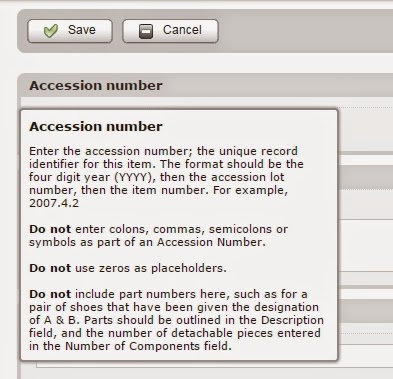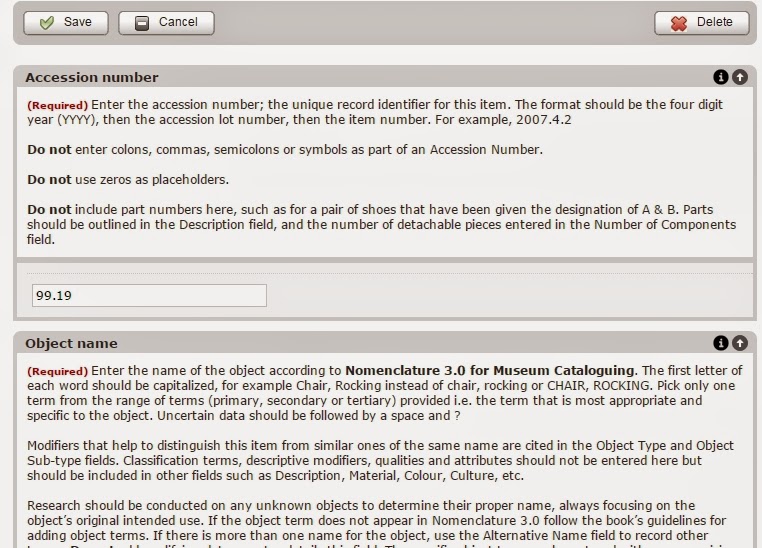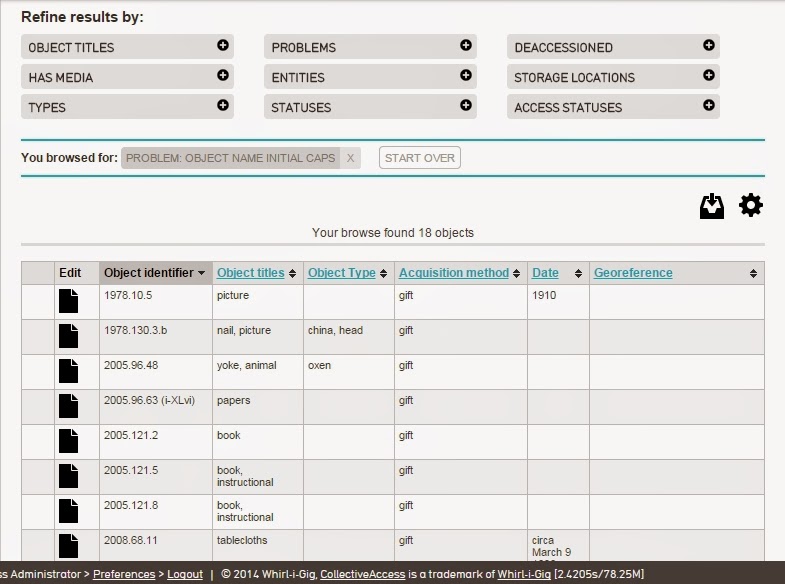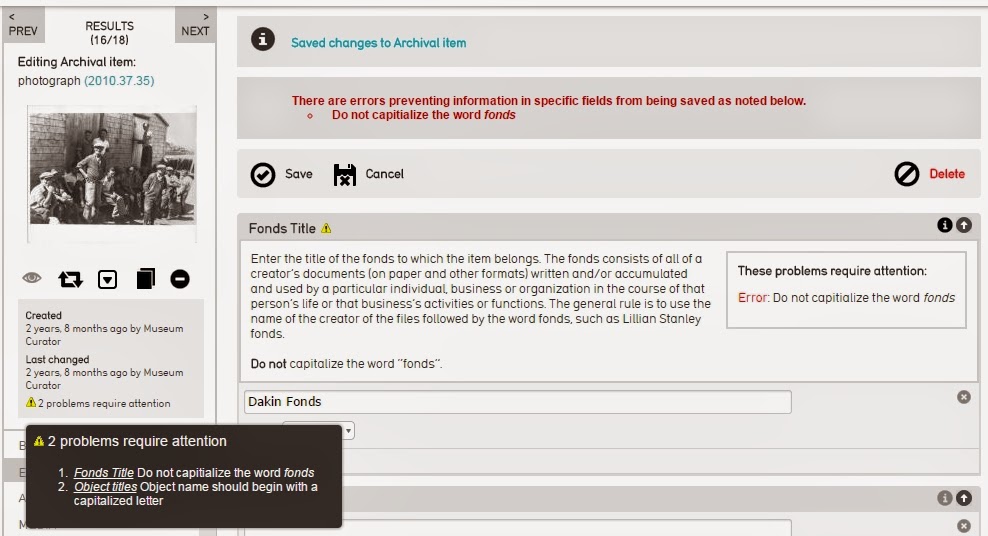Last month I remarked that October flew by, but November full on disappeared. I blinked and it was gone. Last month I was really excited to report that I'd finally gotten my to do list down to 18.5 pages, but this month I've written so many new notes that I'm back up to 22.5 pages. If you will permit me to exclude the last 6 pages of notes from conference goings and meetings, then I guess I made a bit of progress.
I conducted one final site visit of the season which included some photography of WWI artifacts. We have some really amazing artifacts in NS collections. We have just applied for a grant to focus digitization & research efforts on WWI-era items and are keeping our fingers crossed that this will unearth a whole lot of interesting stories and objects. We have an intern coming from Algonquin College to help with this project which is pretty exciting. We love interns!
MCN Conference
 |
| Speed networking under a crazy chandelier |
"those formerly known as the audience"
"the story is the same; it's the telling that is changing"
"if not a lot of people are using it, it doesn't mean you remove, it means you strive to improve"
CMAP
For my out-of-town readers, CMAP is the Community Museums Assistance Program, a provincial funding program that has been under review for the past 4 years. It's been an interesting time with a lot of ideas floating around. As our local readers are aware, this fall ANSM entered into a partnership agreement with the NS Department of Communities, Culture & Heritage (CCH) to rework the evaluation aspect of CMAP. This wasn't a big surprise. The big surprise was when I was asked to take a secondment from my normal work to be the project lead on this undertaking. Did not see that coming. But since we at ANSM like to embrace the crazy, I decided to go for it. I hope that I don't regret that decision, and I hope that the evaluation reworking is successful. Thankfully Chris has stepped in to take over some of my responsibilities while I tackle CMAP. We have a committee in place to help with the work, with a good mix of people from across the province and representing CMAP museums of all shapes and sizes.
Collections Database Info
With my focus shifting to the CMAP evaluation, Chris has taken on the database review work. He wrapped up another museum's system, reviewing 5,972 records. His pace is definitely faster than my pace has been over the past number of months, and it feels great to see progress being made again. We are still very far away from our georeferencing goal (apparently we were a little too ambitious), but we've still managed to map 37,774 artifacts. In Made in Nova Scotia news, we've linked 2,652 artifacts with the business profiles of their creators which is really exciting. We had no idea how that work would go; if we were being naive in thinking we could link thousands of objects to their makers or what kinds of trends we would notice in the process. This is something we've been geeking out on for sure. Every time we link an artifact it feels like we've just won a little victory.
Data entry at all the museums keeps puttering along as we're in the off-season. This month we saw 1,309 new records and 618 images were added to the databases, which means we now have a total of 217,863 artifacts and 89,313 images.
Regionally:
Southwest - 118,877 artifacts, 39,046 images
Central - 41,079 artifacts, 20,312 images
Northeast - 30,690 artifacts, 20,154 images
Cape Breton - 27,217 artifacts, 9,801 images
Congrats to Cape Breton for adding the most records this month and to the Central region for adding the most images.
 Your images of the month are not reminders about 2-dimensional digitization. I know, I'm surprised too. This time we're looking at 3-dimensional items and focusing on the placement of the scale. Placement is tough. You're adding an item to the photo that is rigid and cold to what might otherwise be an organic and warm object. So basically we want to 'hide' the scale. I know, at first glance that doesn't make sense. But hear me out. When you're taking artifact photos, you allow your backdrop to create a frame for the object. It allows the eye to centre and focus on your cool object. So you want to tuck that scale into the frame as though it wasn't there. Looking at the box in the first photo, you'll notice that the scale is really obvious because it isn't squared away with the image frame.It is also so tight to the object that it sort of looks attached. Make sure you can see where your object ends and your scale begins. Now look at the second image. Notice how your eye is drawn to this box? Notice how you can see the scale and yet it isn't distracting you because it fits neatly into the frame? That's what we're going for. It can take a bit of practice but I think you'll agree the end result is worth the extra effort.
Your images of the month are not reminders about 2-dimensional digitization. I know, I'm surprised too. This time we're looking at 3-dimensional items and focusing on the placement of the scale. Placement is tough. You're adding an item to the photo that is rigid and cold to what might otherwise be an organic and warm object. So basically we want to 'hide' the scale. I know, at first glance that doesn't make sense. But hear me out. When you're taking artifact photos, you allow your backdrop to create a frame for the object. It allows the eye to centre and focus on your cool object. So you want to tuck that scale into the frame as though it wasn't there. Looking at the box in the first photo, you'll notice that the scale is really obvious because it isn't squared away with the image frame.It is also so tight to the object that it sort of looks attached. Make sure you can see where your object ends and your scale begins. Now look at the second image. Notice how your eye is drawn to this box? Notice how you can see the scale and yet it isn't distracting you because it fits neatly into the frame? That's what we're going for. It can take a bit of practice but I think you'll agree the end result is worth the extra effort.Membership Renewal
Yes I am still leaving this in. We have a few stragglers who have yet to send in their renewal contract & payment. We hate to keep pestering, but this has to be settled. So again, here are your tips on how to get this done:
1. Complete and send in your contract. Make sure that it is signed by two different people: the President of the Board of Directors and the primary Advisory Service contact person. We won't accept the contract unless it has two different signatures on it.
2. Send us a cheque for $350. $50 covers your regular ANSM membership and $300 covers the Advisory Service. Remember that in your renewal package there was a cost analysis of all the services delivered.
I think that's enough for now. Catch you at the end of the year!































